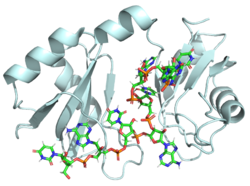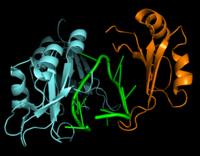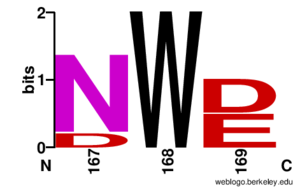Nuclear polyadenylated RNA-binding protein
From Proteopedia
| Line 18: | Line 18: | ||
==Hrp1-RNA Interactions== | ==Hrp1-RNA Interactions== | ||
| - | The interface between Hrp1 and its target RNA sequence is dominated by interactions between key aromatic residues and RNA nucleobases <ref name="GM3H"/>. Only six RNA bases, an <scene name='78/781952/Ua_repeats/1'>(AU)3</scene> repeat, act as the PEE and form specific contacts with Hrp1 <ref name="GM3H"/>. Hydrophilic residues of Hrp1 provide base specificity through hydrogen bonding <ref name="GM3H"/>. Most of the key residues that interact with the RNA can be found in the ß-sheet region of Hrp1; however, loops and the interdomain linker are also essential for Hrp1-RNA recognition <ref name="GM3H"/>. Perhaps the most important Hrp1-RNA interaction is the <scene name='78/781960/Hrp1_scene_ade4trp168/2'>interaction between Ade4 and Trp168</scene> (a conserved residue) <ref name="GM3H"/>. In this case, Trp168 stacks on Ade4 and forms crucial base-specific hydrogen bonds <ref name="GM3H"/>. It is also worth noting that a second Hrp1 residue is critical to holding Ade4 in place, <scene name='78/781945/Lys226-ade4-trp168/1'>Lys226</scene>, which interacts via hydrogen bond with the N1 of Ade4 <ref name="GM3H"/>. A third contributor, <scene name='78/783765/Phe204_and_u7_interaction/1'>Phe204</scene>, also stacks with Ura7 to aid in RNA recognition and binding <ref name="GM3H"/>. | + | The interface between Hrp1 and its target RNA sequence is dominated by interactions between key aromatic residues and RNA nucleobases <ref name="GM3H"/>. Only six RNA bases, an <scene name='78/781952/Ua_repeats/1'>(AU)3</scene> repeat, act as the PEE and form specific contacts with Hrp1 <ref name="GM3H"/>. The kinked conformation around Ade4 is uncommon for RNA alone, and may be adopted by the RNA for specific interactions with Hrp1. Ade4 is part of a crucial interaction with Trp168 which will be discussed later, and could explain the adoption of the kinked conformation. Hydrophilic residues of Hrp1 provide base specificity through hydrogen bonding <ref name="GM3H"/>. Most of the key residues that interact with the RNA can be found in the ß-sheet region of Hrp1; however, loops and the interdomain linker are also essential for Hrp1-RNA recognition <ref name="GM3H"/>. Perhaps the most important Hrp1-RNA interaction is the <scene name='78/781960/Hrp1_scene_ade4trp168/2'>interaction between Ade4 and Trp168</scene> (a conserved residue) <ref name="GM3H"/>. In this case, Trp168 stacks on Ade4 and forms crucial base-specific hydrogen bonds <ref name="GM3H"/>. It is also worth noting that a second Hrp1 residue is critical to holding Ade4 in place, <scene name='78/781945/Lys226-ade4-trp168/1'>Lys226</scene>, which interacts via hydrogen bond with the N1 of Ade4 <ref name="GM3H"/>. A third contributor, <scene name='78/783765/Phe204_and_u7_interaction/1'>Phe204</scene>, also stacks with Ura7 to aid in RNA recognition and binding <ref name="GM3H"/>. |
==RBD-RBD Interactions and the Linker Region== | ==RBD-RBD Interactions and the Linker Region== | ||
Revision as of 15:20, 17 April 2018
Contents |
Introduction
Hrp1 is a polyadenylation factor found in Saccharomyces cervisiae (yeast) [1]. It was discovered when Cleavage Factor I (CF I) was purified and separated into its two components, CF IA and CF IB. CF IB is a single 73 kDa polypeptide. The polypeptide was digested and two tryptic peptides were obtained for sequencing. The sequences were aligned via a database, and Hrp1 was determined to be a perfect match. Hrp1 of CF IB interacts with Rna14 and Rna15 of CF IA[2] to form a protein complex that aids in cleavage, polyadenylation, and transport of the mRNA from the nucleus[3]. Hrp1 specifically recognizes and binds to an RNA sequence in the 3'UTR of the messenger RNA (mRNA) upstream from the cleavage site called the polyadenylation enhancement element (PEE) [1]. Upon binding to the RNA, Hrp1 helps recruit additional proteins necessary for the cleavage and polyadenylation of the RNA molecule [1]. Although Hrp1 shares several common features with other RNA-binding proteins, the unique structural features of the Hrp1-PEE complex reveals the mechanism by which Hrp1 is able to recognize and bind to its specific RNA sequence at the atomic level [1].
Structure
| |||||||||||
Interaction with RNA15
RNA15 is another RNA-binding protein with a single N-terminal RNA recognition motif (RRM) [2]. RNA15 recognizes an A-rich positioning element (PE) downstream from the PEE but upstream from the 3' cleavage site [2]. The recognition of the PE by RNA15 is crucial for precise cleavage of the RNA molecule. Hrp1 and RNA15 are held together by a separate protein, RNA14 [2]. These proteins act together to anchor the polyadenylation and cleavage protein machinery relative to the cleavage site for precise 3'-end processing [2].
Relationship to other proteins
The RNP-type RBD is found in many proteins involved in post-transcriptional pre-mRNA processing (5'-end capping, splicing, 3'-end cleavage and polyadenylation, and transport from the nucleus)[4]. The unique RBD of Hrp1 enables the protein to bind an RNA sequence that differs in both length and content from the RNA sequences of other RNA-binding and mRNA processing proteins such as sex lethal, Poly (A)-binding protein (PABP), and HuD [1]. Like Hrp1, each of these proteins belong to the class of single strand proteins composed of two canonical RBDs; however, these proteins are differentiated by their target RNA sequence, their interactions with RNA at the atomic level, and their interdomain contacts [1]. One way in which Hrp1 differentiates itself from these other proteins is by the fact that Hud, sex lethal, and PABP all contain at least one intra-RNA base-base stacking interaction, a feature that is not found in the Hrp1-PEE complex [1]. It is possible that the intra-RNA interactions found in these other proteins is replaced by the crucial Trp168-Ade4 stacking interaction found in the Hrp1 complex [1]. The fact that the intra-RNA base-base stacking interactions are replaced by the Trp168-Ade4 in the Hrp1-PEE complex might also explain why the Hrp1-RNA interface involves only 6 nucleotides whereas PABP, sex lethal, and HuD require a longer 8-10 nucleotide sequence in the RNA binding pocket [1].
References
- ↑ 1.00 1.01 1.02 1.03 1.04 1.05 1.06 1.07 1.08 1.09 1.10 1.11 1.12 1.13 1.14 1.15 1.16 1.17 1.18 1.19 1.20 1.21 Perez-Canadillas JM. Grabbing the message: structural basis of mRNA 3'UTR recognition by Hrp1. EMBO J. 2006 Jul 12;25(13):3167-78. Epub 2006 Jun 22. PMID:16794580
- ↑ 2.0 2.1 2.2 2.3 2.4 Leeper TC, Qu X, Lu C, Moore C, Varani G. Novel protein-protein contacts facilitate mRNA 3'-processing signal recognition by Rna15 and Hrp1. J Mol Biol. 2010 Aug 20;401(3):334-49. Epub 2010 Jun 19. PMID:20600122 doi:10.1016/j.jmb.2010.06.032
- ↑ Kessler MM, Henry MF, Shen E, Zhao J, Gross S, Silver PA, Moore CL. Hrp1, a sequence-specific RNA-binding protein that shuttles between the nucleus and the cytoplasm, is required for mRNA 3'-end formation in yeast. Genes Dev. 1997 Oct 1;11(19):2545-56. PMID:9334319
- ↑ Clery A, Blatter M, Allain FH. RNA recognition motifs: boring? Not quite. Curr Opin Struct Biol. 2008 Jun;18(3):290-8. doi: 10.1016/j.sbi.2008.04.002. PMID:18515081 doi:http://dx.doi.org/10.1016/j.sbi.2008.04.002
Proteopedia Page Contributors and Editors (what is this?)
Cory A. Wuerch, Matthew Douglas Moore, Savannah Davis, Michal Harel, Jaime Prilusky



